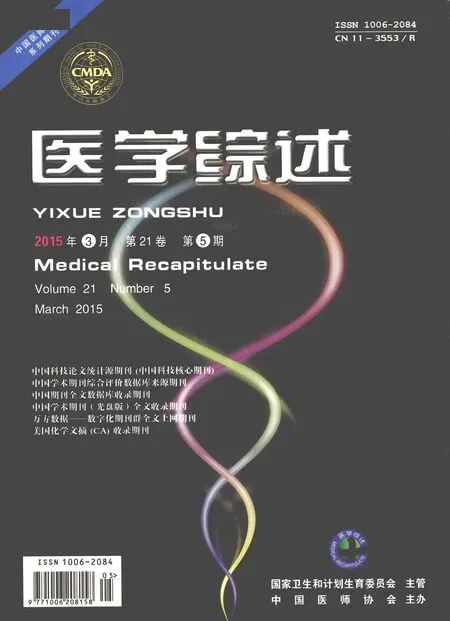血小板在动脉粥样硬化中作用的研究进展
喻志慧(综述),陈煜森(审校)
(1.绍兴市中心医院神经内科,浙江 绍兴 312000; 2.广东医学院附属医院神经内科,广东 湛江 524023)
血小板在动脉粥样硬化中作用的研究进展
喻志慧1(综述),陈煜森2※(审校)
(1.绍兴市中心医院神经内科,浙江 绍兴 312000; 2.广东医学院附属医院神经内科,广东 湛江 524023)
doi:10.3969/j.issn.1006-2084.2015.05.012
血小板除具有黏附、聚集和释放功能外,还具有参与炎症、免疫及支持内皮细胞完整性的功能,在凝血、止血、血栓形成和动脉粥样硬化(atherosclerosis,As)中发挥重要作用,对脑梗死的发生、发展起重要作用。研究表明,血小板功能、数量异常与As等血管疾病的发生有直接关系[1]。血小板通过释放促血管生成因子和生长因子参与维持血管内皮细胞的完整性。失调的血小板和内皮细胞的相互作用作为一个重要的致As机制正逐渐被认可。通过响应特定的促炎信号,血小板与内皮细胞相结合,进而刺激后者产生多种炎性因子,而后者进一步促进内皮细胞与血小板的紧密绑定,从而形成一个正反馈回路。另外,血小板-内皮细胞的绑定能有效地招募白细胞,使白细胞进一步黏附、迁移到血管内皮下。因此,血小板、内皮细胞及白细胞病理性紊乱的相互作用有利于AS炎症过程[2]。现对血小板在AS形成中的作用、机制予以综述。
1血小板的形态与结构
血小板直径为3 μm,厚1 μm,是由人体成熟骨髓巨核细胞裂解产生的无核细胞碎片。平均寿命为7~10 d,一般成人每天产生约1×1011个血小板以维持正常的血小板计数,其主要是在脾脏和肝脏的单核巨噬细胞系统中遭到破坏。血小板生成主要受血小板生成素(主要由肝、肾和骨髓产生的一种酸性糖蛋白)的调节,在紧急情况下,血小板数量可瞬间增加10倍左右[3-4]。血小板颗粒区是细胞器所在的区域,包括α颗粒、致密体和线粒体等。α颗粒中含血小板衍生的生长因子、胰岛素样生长因子1、结缔组织生长因子β、血小板因子4、黏附分子、P-选择素和血小板反应蛋白、纤连蛋白、血管性血友病因子[5-6]。致密颗粒含有血小板激动剂,如腺苷二磷酸(adenosine diphosphate,ADP)、离子化的Ca2+和信号分子(如组胺、5-羟色胺、肾上腺素);线粒体内有血小板代谢需要的酰苷三磷酸和氧化酶。血小板激活和聚集后,颗粒的分泌被认为是下一阶段的血小板活化[7-8]。
2血小板的止血和血栓形成功能
在正常的生理条件下,由于内皮细胞的抗粘连性的生物学性能,循环中的血小板不与邻近的内皮细胞形成稳定的黏附接触。然而,在血管壁损伤后,暴露出内皮下结构,包括胶原蛋白、血管性血友病因子、纤连蛋白和层粘连蛋白,内皮细胞激活后血管性血友病因子从内皮细胞急性释放,在高剪切应力作用下,如动脉狭窄,血管性血友病因子可作为一种桥梁分子通过同时结合胶原蛋白与血小板糖蛋白ⅠB-Ⅴ-Ⅸ从而介导血小板与内皮的黏附[9]。这种黏附具有较高的解离速率,导致血小板在血管壁的易位,易位后的血小板通过与胶原蛋白、纤连蛋白和层粘连蛋白结合形成稳定的黏附,其分别由血小板膜糖蛋白Ⅵ和整合素α2β1、α5β1和α6β1介导[10-12],附着后的血小板在血小板诱导剂的作用下,经历了显著的一系列复杂的形态和生化学变化并导致血小板颗粒内容物的释放,上调黏附功能并活化整合素α2β3,活化的α2β3结合多个配位体,包括血管性血友病因子、纤维蛋白原、血纤维蛋白和纤维连接蛋白,其对稳定的血小板聚集形成是必不可少的[13-14]。
3血小板的促炎作用
越来越多的病理生理过程表明,血小板促进大量的不同类型的细胞相互作用,包括内皮细胞、嗜中性粒细胞、单核细胞、树突状细胞、细胞毒性T淋巴细胞、疟疾感染红细胞及多种肿瘤细胞。在As过程中,血小板与血管内皮细胞及白细胞的相互作用对于萌生和扩展动脉壁上的炎症过程起重要作用[15]。
3.1血小板与内皮细胞的黏附尽管血小板持续与循环内皮细胞接触,但在生理条件下,它们通常不形成持久的粘接作用,其主要由内皮细胞通过3个内在途径起抗粘连作用,分别是一氧化氮、ecto-ADPase/CD39/NTPDase和ecosanoid-arachidonic acid-prostacyclin途径[16]。通过破坏这些抗粘性机制和增加内皮细胞黏附分子的表达,炎症刺激促使内皮血小板持久黏附[17]。血小板黏附到“发炎的血管内皮细胞”涉及到协调的多步骤过程,包括血小板牵引、表面易位、黏附牢固[18]。在高脂血症环境中,内皮细胞活化、修饰的脂蛋白颗粒、活性氧类的积累使血管内膜内皮发炎[19]。这导致了内皮细胞P-和E-选择素以及膜von Willebrand因子的表达[18,20],P-选择素结合的血小板受体包括糖蛋白Ⅰbα和P-选择素糖蛋白1[21-22],内皮细胞通过与后者受体结合进而招募血小板黏附于其表面。但内皮细胞如何与血小板牢固结合的确切机制仍不明了,在体外和体内模型表明,通过纤维蛋白原α2β3的复合物结合血管内皮细胞整合素α5β3或细胞间黏附分子1,有利于血小板牢固的黏附和活化。血小板活化后分泌许多生物活性物质从而改变内皮细胞的趋化和黏附性能,使单核细胞及其他白细胞向内皮细胞下炎症部位侵袭[18,23]。As形成的体内模型实验表明,内皮细胞和活化的血小板之间的相互作用在As的起始阶段极可能是至关重要的[24-25]。
3.2血小板与白细胞的相互作用白细胞,特别是单核细胞和T淋巴细胞,在As的发展中起着至关重要的作用[26]。越来越多的证据表明,血小板黏附到发炎的血管内皮细胞活化后,可提高白细胞募集、活化、迁移,从而加重As相关的炎症过程[2]。血小板通过牢固地结合内皮细胞进而招募白细胞侵袭入血管内皮下,其过程是一个协调的、多步骤的过程,涉及选择素介导的牵引和滚动,其次是β2整合素介导的稳定黏附。其中血小板P-选择素与白细胞P-选择素糖蛋白1的结合,在最初捕获白细胞P-选择素糖蛋白1中起了非常关键的作用[2,27],并最终激活白细胞β2整合素,包括巨噬细胞抗原1和淋巴细胞功能相关抗原1。巨噬细胞抗原1是主要的β2整合素,有利于白细胞牢固地黏附于血小板的表面上,通过结合多个配位体,包括糖蛋白Ⅰbα启动细胞间黏附分子2和连接黏附分子3[28-30],并通过纤维蛋白原结合到α2β3[18,31]。血小板活化,继而存储在血小板α颗粒中的众多趋化因子释放。这些趋化因子可以被释放到血液循环中,或在血小板表面,从而在As过程中发挥生物活性[32-33]。
4小结
人们很早就认识到,动脉血栓的形成类似于一个放大的生理止血反应。而血小板在As的萌生和扩展中的作用也类似于这种放大的概念。血小板与内皮细胞相互作用,以维持其生理功能,增强白细胞向炎症部位的招募。不断地改善认识血小板在As过程中的促血栓形成及促炎的机制,可以提高防治这一重大疾病临床并发症的可能性。
参考文献
[1]Reape TJ,Groot PH.Chemokines and atherosclerosis[J].Atherosolersis,1999,147(2):213-225.
[2]Kaplan ZS,Jackson SP.The role of platelets in atherothrombo-sis[J/OL].Hematology Am Soc Hematol Educ Program,2011,2011:51-61.http://asheducationbook.hematologylibrary.org/content/2011/1/51.long.
[3]Munro N.Hematologic complications of critical illness:anemia,neutropenia,thrombocytopenia,and more[J].AACN Adv Crit Care,2009,20(2):145-154.
[4]Waugh A,Grant A.Ross and Wilson Anatomy and Physiology in Health and Illness[M].10 th ed.Edinburgh:Churchill Livingstone Elsevier,2006:253-262.
[5]Blair P,Flaumenhaft R.Plateletalpha-granules:basic biology and clinical correlates[J].Blood Rev,2009,23(4):177-189.
[6]Flaumenhaft R.α-granules:a story in the making[J].Blood,2012,120(25):4908-4909.
[7]Rendu F,Brohard-Bohn B.The platelet release reaction:granules′ constituents,secretion and functions[J].Platelets,2001,12(5):261-273.
[8]McNicol A,Israels SJ.Platelet dense granules:structure,function and implications for haemostasis[J].Thromb Res,1999,95(1):1-18.
[9]Luo GP,Ni B,Yang X,etal.von Willebrand factor:more than a regulator of hemostasis and thrombosis[J].Acta Haematol,2012,128(3):158-169.
[10]Deckmyn H,De Meyer SF,Broos K,etal.Inhibitors of the interactions between collagen and its receptors on platelets[J].Handb Exp Pharmacol,2012(210):311-337.
[11]Schaff M,Tang C,Maurer E,etal.Integrin α6β1is the main receptor for vascular laminins and plays a role in platelet adhesion,activation,and arterial thrombosis[J].Circulation,2013,128(5):541-552.
[12]Nieswandt B,Varga-Szabo D,Elvers M.Integrins in platelet activation[J].J Thromb Haemost,2009,7(Suppl 1):206-209.
[13]Joo SJ.Mechanisms of Platelet Activation and Integrinα2β3[J].Korean Circ J,2012,42(5):295-301.
[14]Jackson SP.The growing complexity of platelet aggregation[J].Blood,2007,109(12):5087-5095.
[15]Borissoff JI,Spronk HM,ten Cate H.The hemostatic system as a modulator of atherosclerosis[J].N Engl J Med,2011,364(18):1746-1760.
[16]Jin RC,Voetsch B,Loscalzo J.Endogenous mechanisms of inhibition of platelet function[J].Microcirculation,2005,12(3):247-258.
[17]Gawaz M,Neumann FJ,Ott I,etal.Platelet function in acute myocardial infarction treated with direct angioplasty[J].Circulation,1996,93(2):229-237.
[18]Gawaz M,Langer H,May AE.Platelets in inflammation and atherogenesis[J].J Clin Invest,2005,115(12):3378-3384.
[19]Libby P,Ridker PM,Maseri A.Inflammation and atherosclerosis[J].Circulation,2002,105(9):1135-1143.
[20]Wagner DD,Frenette PS.The vessel wall and its interactions[J].Blood,2008,111(11):5271-5281.
[21]Frenette PS,Denis CV,Weiss L,etal.P-Selectin glycoprotein ligand 1(PSGL-1) is expressed on platelets and can mediate platelet-endothelial interactions in vivo[J].J Exp Med,2000,191(8):1413-1422.
[22]Romo GM,Dong JF,Schade AJ,etal.The glycoprotein Ⅰb-Ⅸ-Ⅴ complex is a platelet counterreceptor for P-selectin[J].J Exp Med,1999,190(6):803-814.
[23]Davì G,Patrono C.Platelet activation and atherothrombosis[J].N Engl J Med,2007,357(24):2482-2494.
[24]Massberg S,Brand K,Grüner S,etal.A critical role of platelet adhesion in the initiation of atherosclerotic lesion formation[J].J Exp Med,2002,196(7):887-896.
[25]Belton OA,Duffy A,Toomey S,etal.Cyclooxygenase isoforms and platelet vessel wall interactions in the apolipoprotein E knockout mouse model of atherosclerosis[J].Circulation,2003,108(24):3017-3023.
[26]Ross R.Atherosclerosis--an inflammatory disease[J].N Engl J Med,1999,340(2):115-126.
[27]McEver RP,Cummings RD.Perspectives series:cell adhesion in vascular biology.Role of PSGL-1 binding to selectins in leukocyte recruitment[J].J Clin Invest,1997,100(3):485-491.
[28]Simon DI,Chen Z,Xu H,etal.Platelet glycoprotein ibalpha is a counterreceptor for the leukocyte integrin Mac-1(CD11b/CD18)[J].J Exp Med,2000,192(2):193-204.
[29]Diacovo TG,deFougerolles AR,Bainton DF,etal.A functional integrin ligand on the surface of platelets:intercellular adhesion molecule-2[J].J Clin Invest,1994,94(3):1243-1251.
[30]Santoso S,Sachs UJ,Kroll H,etal.The Junctional Adhesion Molecule 3 (JAM-3) on Human Platelets is a Counterreceptor for the Leukocyte Integrin Mac-1[J].J Exp Med,2002,196(5):679-691.
[31]Weber C,Springer TA.Neutrophil accumulation on activated,surface-adherent platelets in flow is mediated by interaction of Mac-1 with fibrinogen bound to alphaⅡbbeta3 and stimulated by platelet-activating factor[J].J Clin Invest,1997,100(8):2085-2093.
[32]Koenen RR,Weber C.Platelet-derived chemokines in vascular remodeling and atherosclerosis[J].Semin Thromb Hemost,2010,36(2):163-169.
[33]Gleissner CA,von Hundelshausen P,Ley K.Platelet chemokines in vascular disease[J].Arterioscler Thromb Vasc Biol,2008,28(11):1920-1927.
摘要:血小板是由人体骨髓巨核细胞裂解产生的无核细胞碎片,因其在止血和血栓形成中的重要作用而被熟知。血小板的促炎症反应功能可调节动脉粥样硬化(As)的起始及发展过程的各个方面。通过释放趋化因子、促炎症分子和其他生物反应调节剂,血小板与内皮细胞及白细胞之间的相互作用建立了一套加速动肪粥样硬化进程的局部炎症反应进程。
关键词:血小板;动脉粥样硬化;内皮细胞;白细胞
Research Advances on the Function of Platelets in AtherosclerosisYUZhi-hui1,CHENYu-sen2.(1.DepartmentofNeurology,ShaoxingCentralHospital,Shaoxing312000,China; 2.DepartmentofNeurology,theAffiliatedHospitalofGuangdongMedicalCollege,Zhanjiang524023,China)
Abstract:Platelets that derive from human bone marrow megakaryocytes cleavage of nuclear cell debris, have long been known because of its central role in hemostasis and thrombosis.The proinflammatory function of platelet can adjust various aspects of the atherosclerosis(As) process,including its initiation and progress.Through release of chemokines,pro-inflammatory molecules,and other biological response modifiers,the interaction among platelets,endothelial cells,and leukocytes establishes a localized inflammatory response that accelerates As.
Key words:Platelets; Atherosclerosis; Endothelial cells; Leukocytes
收稿日期:2014-01-10修回日期:2014-08-12编辑:孙洪芳
中图分类号:R741
文献标识码:A
文章编号:1006-2084(2015)05-0799-03

